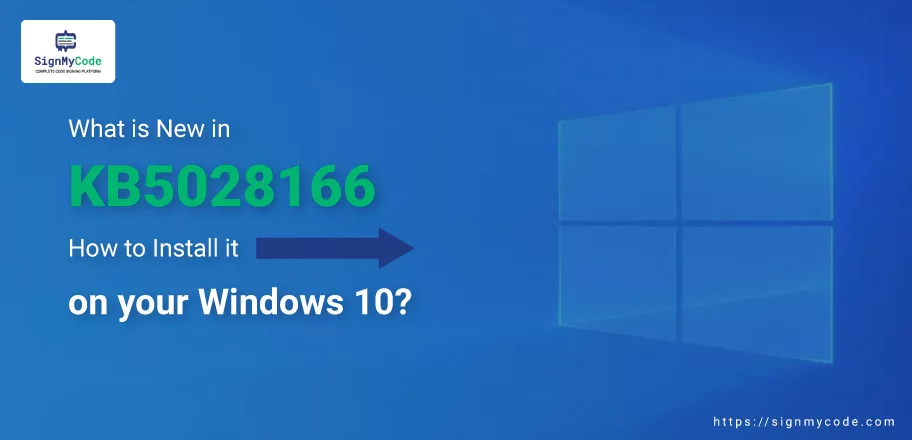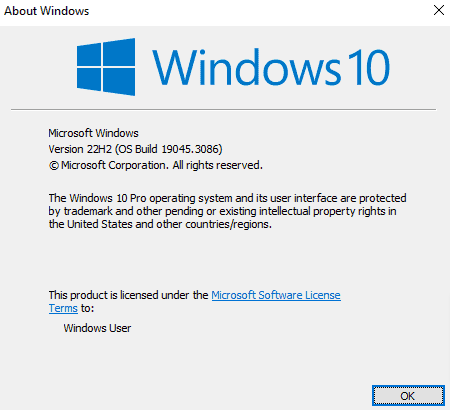What is New in KB5028166? How to Install KB5028166 on your Windows 10?

In July 2023, Microsoft released a cumulative update, KB5028166, per their Patch Tuesday schedule. The primary purpose of this cumulative update was to fix the issues in Windows OS. It was recommended that the KB5028166 be installed for efficient working.
So, let’s discover what is KB5028166 and how you can install it on Windows 10.
What is KB5028166?
KB5028166 is a cumulative update released by Microsoft for its Windows 10 operating system. Primarily, it’s for fixing bugs and improving the system security. It was released per the Patch Tuesday schedule, under which Microsoft provides an update every second Tuesday of the month.
On July 11th, 2023, KB5028166 was released, and it was recommended to be installed immediately.
Compatible Windows 10 OS Version with KB5028166
Only two versions of Windows 10 are compatible with the KB5028166 cumulative update. The versions include:
- Windows 10 22H2
- Windows 10 21H2
You should immediately install this update if you use any of the mentioned versions.
To verify the version of your Windows 10 OS, follow the below steps:
Step 1: Open the Run dialog using the “Win + R” combination.
Step 2: In the text field, input “winter” and click on “OK“
Step 3: The OS will display you the version of your Windows 10. You will see a similar dialog as demonstrated.

Furthermore, if you have installed the KB5027293 update, you can skip installing the KB5028166. To verify the installation of KB5027293, you can undergo any of the below two approaches.
Approach #1: Viewing installed updates using Control Panel
Step 1: Access the “Control Panel”. You can open it by inputting “Control Panel” in the taskbar. In addition, you can use “Win + X” to open the menu from the lower-left corner. From the provided options, choose “Control Panel”.
Step 2: Go to “Programs and Features” option.
Step 3: Select on the “View Installed Updates” option on the left side.
Step 4: In the search bar at right, input “KB5027293”.
Step 5: If the update is listed, then it’s installed on your system. Otherwise, you should install the “KB5028166”.
Approach #2: Verifying installed updates using the Windows update history
Step 1: Access the system settings by pressing “Win + I” combination.
Step 2: Open the “Update & Security” settings.
Step 3: Select the “View update history” option.
Step 4: Go through the list of installed updates to find the “KB5027293”. You can also use “Ctrl + F” to discover a particular update.
Step 5: If the update is present in the list, it’s installed; otherwise not.
The New Characteristics of KB5028166
This cumulative update is mainly for fixing bugs in the Windows 10 operating system. It offers the following new functionalities/fixes.
Functionalities:
Improved Authentication
The update offers an enhanced authentication mechanism for Microsoft services, like Azure and OneDrive. It helps strengthen the platform’s security and satisfies the need for conditional access checks.
Enhanced Quality Chinese Font
The simplified Chinese fonts are improved by the KB5028166 update. Now, the fonts will be clearer, and users can efficiently bold them and change the size, retaining the quality. Thus, a clean and structured look of Chinese font will appear on the screen.
GB18030-2022 Implementation
This cumulative update enables the compatible Windows 10 to support the standard list of Chinese characters, including Yahei, Dengxian, and Simsum. The characters in all the lists will be light and bold, ensuring a smooth experience for users.
Fixtures:
The bug fixes offered by KB5028166 are as follows:
- The task schedule is improved, enabling the tasks to run per the defined date and time.
- The tib.sys and spooler service is fixed, ensuring more stability, performance, and functionality.
- A stable user interface is provided with the fixture of DWM (Desktop Window Manager).
- The crash of the Start Menu and issues in Window Search have been fixed.
The Process To Install the KB5028166 on Windows 10
There are four primary approaches to installing the KB5028166 cumulative update. You need to select a reliable approach per your infrastructure and requirements.
Approach #1: Using the Windows Update
To install the update on your personal Windows 10 system, follow the steps below:
Step 1: Use the start button and open the system settings.
Step 2: Select the “Update & Security” option.
Step 3: From the option provided on the left side, choose “Window Update”
Step 4: Click on the button with “Check for Updates”
Step 5: If an update is available, it will display you the “Download and Install” button. Click on that, and the update will be installed. But remember to restart the system after KB5028166 installation.
Approach #2: Downloading from Microsoft Update Catalog
Microsoft publishes its update on the Update Catalog website. You can download the KB5028166 and install it on your system. The steps are simple, as defined below:
Step 1: Navigate to the Microsoft Update Catalog website.
Step 2: Search for the “KB5028166” update. Once the webpage lists it, use the download button to save it on your computer.
Step 3: Navigate to the downloaded file location and run it.
Step 4: Follow the instructions simultaneously and install the update.
Step 5: Restart your system to let commit and make relevant modifications.
Approach #3: Through WSUS (Windows Server Update Services)
The WSUS approach is for organizations handling a large number of systems connected to a centralized update server. By using this method, a firm can install the update on all Windows 10 22H2 systems simultaneously. This process includes the following steps:
Step 1: Access your WSUS (Windows Server Update Services) console.
Step 2: You need to expand the “Update Services” to select “Updates”
Step 3: Under “All Updates” find “Cumulative Update for Windows 10 Version 22H2 for x64-based Systems (KB5028166)”.
Step 4: Once you find it, use the right-click >> Update >> Approve.
Step 5: Choose the systems you want to update.
After these five steps, KB5028166 will start getting downloaded and installed on the defined systems/groups.
Approach #4: Using SCCM (System Center Configuration Manager)
The SCCM is also used in enterprises to manage the updates of multiple systems at once. If you also have SCCM configured, execute the following steps:
Step 1: Open the console on your SCCM computer system.
Step 2: From the left-side pane, select “Software Library”
Step 3: Now, expand the “Software Updates” >> All Software Updates/All Windows Update.
Step 4: With the help of the search bar, find the “KB5028166″ cumulative update.
Step 5: Once the SCCM displays the update, use the right-click to download it. You will require a deployment package to install it on Windows computers.
Step 6: Again, use the right-click on downloaded Kb5028166 file and click “Deploy” It will display a wizard on the screen.
Step 7: Configure the settings in the Wizard per convenience and schedule.
Step 8: Monitor the progress as the update is being installed on the specified Windows 10 22H2 computer systems.
Furthermore, once you install the update using any of the mentioned approaches, it’s recommended that you perform the system cleanup.
System Cleanup Procedure:
To do so, you need to open the command line or the PowerShell with administrative privileges and follow the below steps.
Step 1: Assess the component store by running the following command:
dism.exe /Online /Cleanup-Image /AnalyzeComponentStoreIt will help you identify the disk space, which can be achieved after cleaning the unnecessary files.
Step 2: Execute the cleanup command to remove unnecessary and superseded files from the update repository. As a result, you will reclaim the storage space for other functions.
DISM.exe /Online /Cleanup-Image /StartComponentCleanup /ResetBaseStep 3: Execute a complete Windows 10 update cleanup with the following command.
DISM.exe /Online /Cleanup-Image /StartComponentCleanup /ResetBaseWith this command, you will remove the superseded files associated with every component. But you need to remember that it’s a non-reversible action. So, you should ensure that all the updates are installed before running it.
Step 4: Now, use the disk cleanup utility, available by default in the Windows OS, to delete the temporary files. The command will show you a list from which you are required to choose the category of the files to remove.
cleanmgr.exe /verylowdiskAfter the cleanup, your KB5028166 installation procedure is completed.
Uninstallation Process: In Case You Want To Revert Back
In case the update is not compatible with your Windows or it creates issues, then you can uninstall it through the following two methods.
Method #1: Using the Control Panel
Step 1: Open the “Control Panel” interface and navigate to “Programs and Features“.
Step 2: From the left pane, select “View installed updates”
Step 3: Find the “KB5028166”, right-click on it and select “Uninstall”
Step 4: Follow the procedure, and it will be uninstalled. Lastly, restart the machine to let changes take place.
Method #2: Using the CLI
Step 1: Access the Command prompt or PowerShell with administrative privileges. You can use “Win + X” to open any of the CLI.
Step 2: Run the command: wusa /uninstall /kb:5028166
Step 3: Wait for the execution to complete, and then restart your Windows machine.
Wrapping Up
KB5028166 is a patch Tuesday update from Microsoft, which was released to fix the Chinese font and provide an authentication mechanism. It was released in July 2023 and is considered as a crucial update for the operating system.
To install it, you can use the Windows update settings, WSUS, and SCCM per the infrastructure and convenience. And also, remember to clean up the system after it. However, if the update causes issues, you can uninstall it through the command prompt and control panel.
